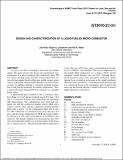| dc.contributor.author | Peck, Jay | |
| dc.contributor.author | Jacobson, Stuart | |
| dc.contributor.author | Waitz, Ian A | |
| dc.date.accessioned | 2018-06-11T16:32:25Z | |
| dc.date.available | 2018-06-11T16:32:25Z | |
| dc.date.issued | 2010-06 | |
| dc.identifier.isbn | 978-0-7918-4400-7 | |
| dc.identifier.uri | http://hdl.handle.net/1721.1/116209 | |
| dc.description.abstract | As part of an effort to develop a microscale gas turbine engine, this paper presents the design and experimental characterization of a micro-combustor that catalytically burns JP8 fuel. Due to the high energy densities of hydrocarbon fuels, mi-croscale heat engines based on them may enable compact power sources with specific energies higher than those of current battery systems. In addition, utilizing a commonly available logistics fuel would provide advantages for military applications. Thus, a microscale engine burning JP8 fuel is attractive as a portable power source. A liquid-fueled micro-combustor with a combustion chamber volume of 1.4 cm 3 and an overall die size of 36.4 mm × 36.4 mm × 6.5 mm was designed, micro-fabricated, and experimentally characterized. Two configurations were tested and compared; one with the combustion chamber entirely filled with a catalyst, and the other with the combustion chamber partially filled with a catalyst. In the configuration filled with a catalyst, JP8 combustion was sustained at mass flow rates up to 0.1 g/sec, and an exit gas temperature of 780 K; an overall combustor efficiency of 19%, and a power density of 43 MW/m 3 were achieved. The primary limitation on increasing the mass flow rates and temperature further was structural failure of the device due to thermal stresses. With the partially-filled configuration, a mass flow rate of 0.2 g/sec, and a corresponding power density of 54 MW/m 3 were obtained. The exit gas temperature for the partially-filled configuration was as high as 720 K, and the maximum overall efficiency was over 22%. Although the reduced amount of catalyst led to incomplete combustion, smaller thermal losses resulted in an increase in the overall combustor efficiency and power density. A non-dimensional operating map was constructed based on the experiment, and it suggests that improving the thermal efficiency would be necessary to achieve higher efficiencies in the device. | en_US |
| dc.description.sponsorship | United States. Defense Advanced Research Projects Agency | en_US |
| dc.description.sponsorship | Micro Autonomous Systems and Technology Consortium. Collaborative Technology Alliance (Program DAAD19-01-2-0010) | en_US |
| dc.publisher | ASME International | en_US |
| dc.relation.isversionof | http://dx.doi.org/10.1115/GT2010-23388 | en_US |
| dc.rights | Article is made available in accordance with the publisher's policy and may be subject to US copyright law. Please refer to the publisher's site for terms of use. | en_US |
| dc.source | ASME | en_US |
| dc.title | Design and Characterization of a Liquid-Fueled Micro-Combustor | en_US |
| dc.type | Article | en_US |
| dc.identifier.citation | Peck, Jay, Stuart A. Jacobson, and Ian A. Waitz. “Design and Characterization of a Liquid-Fueled Micro-Combustor.” Volume 5: Industrial and Cogeneration; Microturbines and Small Turbomachinery; Oil and Gas Applications; Wind Turbine Technology (2010). | en_US |
| dc.contributor.department | Massachusetts Institute of Technology. Department of Aeronautics and Astronautics | en_US |
| dc.contributor.mitauthor | Jacobson, Stuart | |
| dc.contributor.mitauthor | Waitz, Ian A | |
| dc.relation.journal | Volume 5: Industrial and Cogeneration; Microturbines and Small Turbomachinery; Oil and Gas Applications; Wind Turbine Technology | en_US |
| dc.eprint.version | Final published version | en_US |
| dc.type.uri | http://purl.org/eprint/type/ConferencePaper | en_US |
| eprint.status | http://purl.org/eprint/status/NonPeerReviewed | en_US |
| dc.date.updated | 2018-04-12T13:38:26Z | |
| dspace.orderedauthors | Peck, Jay; Jacobson, Stuart A.; Waitz, Ian A. | en_US |
| dspace.embargo.terms | N | en_US |
| dc.identifier.orcid | https://orcid.org/0000-0001-7924-8161 | |
| mit.license | PUBLISHER_POLICY | en_US |
